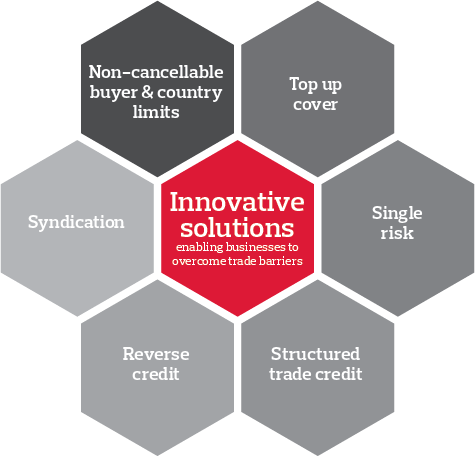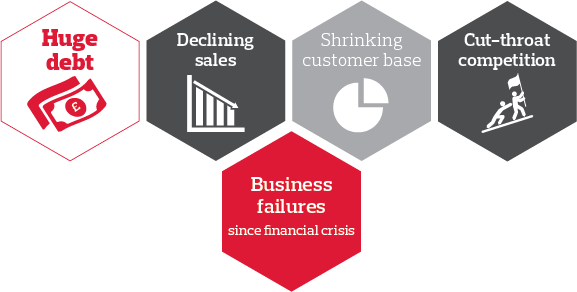Positive global macroeconomic forecasts are helping support a fragile confidence for businesses trading on global markets. But downside risks like the delicate balance between low wages and high consumer debt are encouraging companies to seek new ways to protect their balance sheets.
In September, a large US toy retailer fell into administration with over USD 5bn of debt. Not only had consumer spending begun to drift away, but its top line income was being eaten into by larger competitors and online rivals. Sadly, its leadership team failed to address or mitigate the problem and this reminds us of the threat these risk dynamics pose to sectors across the global economy.
Macro-economic trends
The good news is that WTO data tells us global growth is firming broadly as expected. Manufacturing and trade are picking up, confidence is improving and international financing conditions remain benign. Global growth is projected to strengthen to 2.7% in 2017 and 2.9% 2018-19, in line with January forecasts.
In emerging market and developing economies (EMDEs), growth is predicted to recover to 4.1% in 2017 and reach an average of 4.6 percent in 2018-19, as obstacles to growth in commodity exporters diminish, while activity amongst commodity importers continues to be robust.


Downside risk
Nevertheless, risks to the global outlook remain tilted to the downside. These include increased trade protectionism, elevated economic policy uncertainty, the possibility of financial market disruptions and, over the longer term, weaker potential growth.

U.S. monetary policy has tightened gradually, but a faster pace could impact global financing conditions. In Europe monetary policy has remained unchanged in an attempt to help the recovery increase in depth as growth rates across member countries converge at a higher level. While Europe shows one or two signs of recovery, the uncertainty and additional volatility that is caused by the ongoing Brexit negotiations cannot be ignored.
Inflation has eased among EMDE commodity exporters, allowing room for cuts in policy interest rates. With deficits prevailing across EMDEs, and debt on a rising path, especially in commodity exporters, there isn’t a lot of space for movement in monetary policy terms.

Growth is projected to gain strength in both advanced, emerging and developing economies (EMDEs). The pickup in global trade partly reflects a bottoming out of global investment, which is relatively import-intensive. The projected recovery in EMDEs is largely driven by expectations of diminishing obstacles to activity amongst commodity exporters.
Meanwhile, China is expected to become the world’s largest economy by 2050. Its third quarter growth met expectations at 6.8%, above Beijing’s annual target of 6.5%, but what happens in China impacts the global economy, and the government is trying to rein in debt and manage the housing bubble without hurting overall growth. This could slow the global economy in the short/medium term, particularly as China’s historic 10% year on year average growth for three decades until the financial crisis, now appears to be a thing of the past.
What does this mean for business?
While every trading sector can be different it is worth noting that a toxic mix of huge debt, declining sales, shrinking customer base and cutthroat competition have laid the foundations of a number of business failures since the financial crisis.
It is with these sobering facts that more businesses are turning towards trade credit insurance. The ability to insure customer debts has become increasingly popular as companies’ risk profiles have changed. Rather than simply a risk mitigation tool credit insurance is being deployed as a product with far wider reaching benefits, allowing companies to secure opportunities for growth and funding alongside indemnity against failure.

Innovative solutions have been established that enable a business to overcome barriers to trade and provide a solid platform to enable trade within a sound financial structure. Non – cancellable buyer and country limits, top up cover, syndication, single risk, reverse credit and structured trade credit are now widely used across the global trade credit arena.
With global macroeconomic activity delicately poised, the pressure on consumer spending does create uncertainty and as a result the margin for error in projected growth by the WTO is fairly wide. The spectre of debt, declining sales and potentially shrinking customer numbers cannot be ignored. If you factor in other geopolitical risks or the threat of natural disasters, the equilibrium can quickly turn. One need only look to the effects of an above average North Atlantic hurricane season or the current political turmoil on the Korean peninsula to understand that any one of these additional threats could be the single factor which puts global trade back into the red.

For more information about Trade Credit click here
Aon UK Limited is authorised and regulated by the Financial Conduct Authority. FPNAT.391